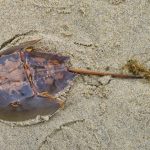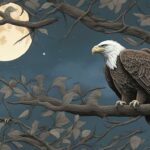All 50 states in the US have an Official State Bird. This bird has been voted for by the local legislation and represents the spirit of the state.
Here we have compiled a full list of all the states and the state birds. So now you can keep an eye out for the official State Birds.
Here is the list in alphabetical order:
What Is The State Bird of Alabama?
- Common Name: Northern Flicker
- Scientific Name: Alabama argillacea
- Diet: Omnivores
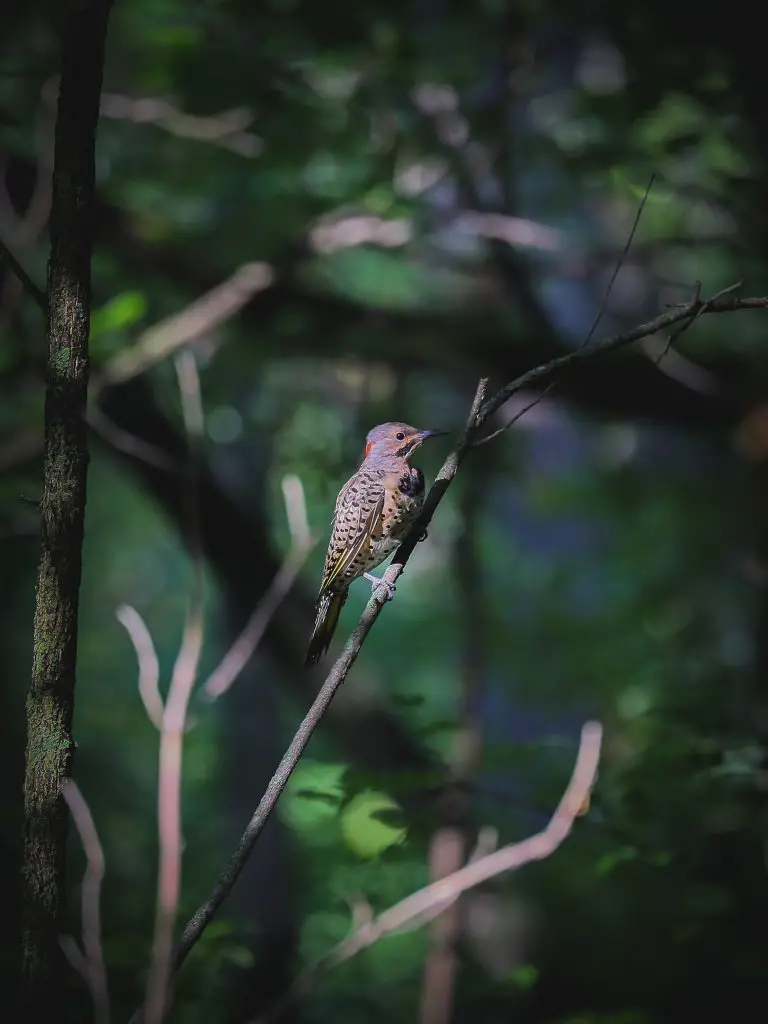
The northern flicker, often known as the yellowhammer, belongs to the woodpecker family, but unlike other woodpeckers, it migrates. It was dubbed the yellowhammer after the grey-and-yellow uniforms worn by Alabama troops during the Civil War. It became the official bird of Alabama in 1927.
Why Northern Flicker Is The State Bird of Alabama?
In 1927, it was declared as the official state bird of Alabama, owing to a narrative of a Civil War unit from Huntsville arriving at a fight wearing spotless uniforms with yellow fabric at the sleeves and coattails.
What is The State Bird of Alaska?
- Common Name: Willow Ptarmigan
- Scientific Name: Lagopus lagopus
- Diet: Herbivores
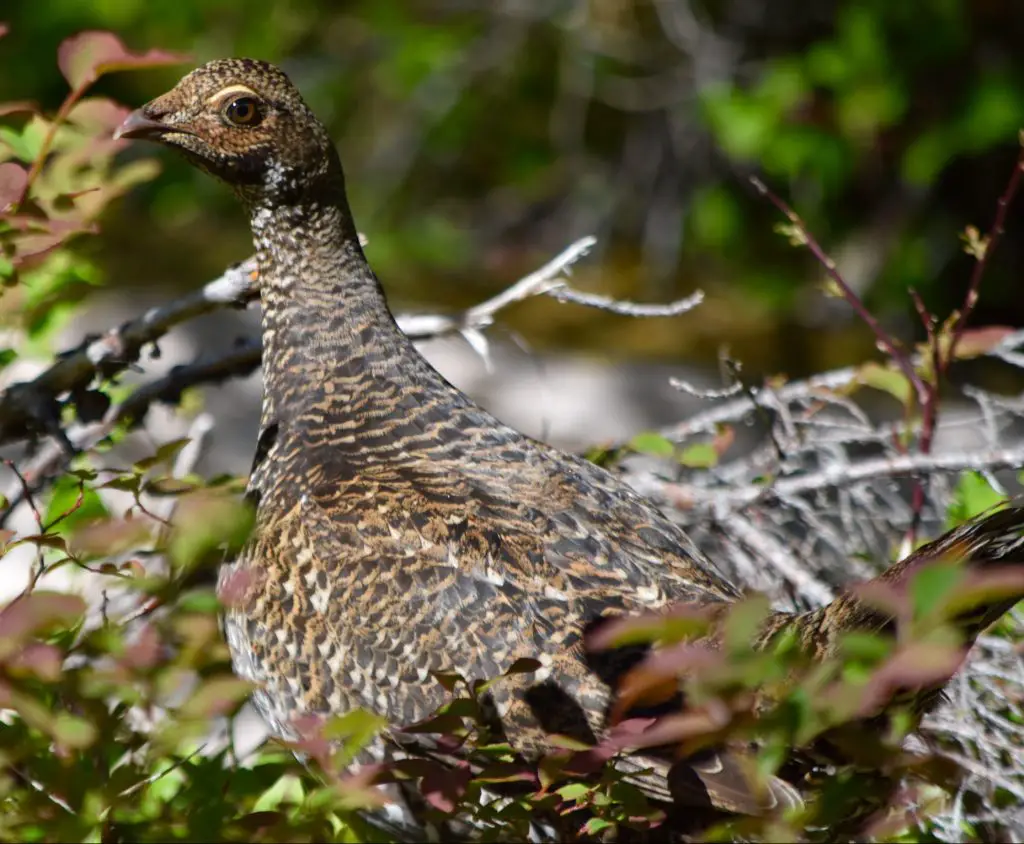
The willow ptarmigan is excellent at camouflaging itself. Its feathers become white in the winter to mimic snow and light brown in the summer to mimic the sun (to blend in with the ground). It is a ground-dwelling bird found in Alaska’s tundra. Alaskan schoolchildren chose the willow ptarmigan to be the state bird.
Why Willow Ptarmigan Is The State Bird of Alaska?
Because of its effective use of camouflage as a predator defense, the willow ptarmigan was chosen as Alaska’s official state bird. The residents of the state were stunned by the state’s creativity in switching its plumage from light brown in the summer to pure white in the winter.
What Is The State Bird of Arizona?
- Common Name: Cactus wren
- Scientific name: Campylorhynchus brunneicapillus
- Diet: Carnivore
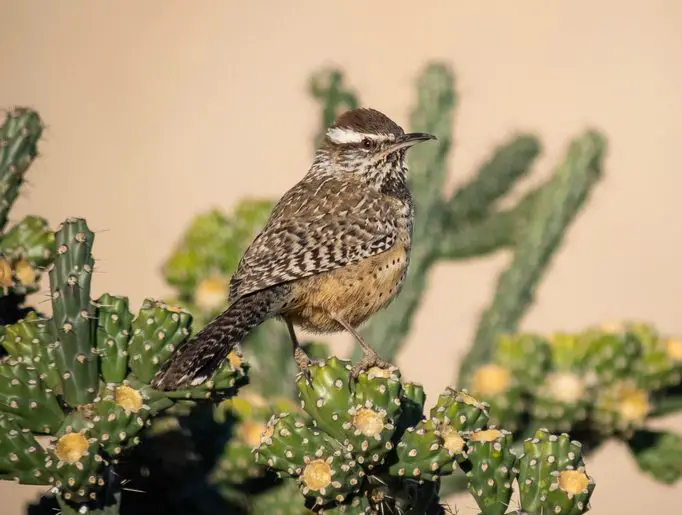
The cactus wren is a wren species found only in the southwestern United States and northern and central Mexico. It is the biggest wren in the United States and the official bird of Arizona. The Cactus Wren is a speckled brown bird with bright white eyebrows that go from the bill to the sides of the neck, across and over their red eyes. They have a white chest with black speckles and pale cinnamon sides.
Why Cactus Wrens Is The State Bird of Arizona?
The state bird of Arizona was chosen because of its native status and distinctive singing. It picked the cactus wren, in part, so that the state could have its own bird.
What Is The State Bird of Arkansas?
- Common Name: Northern Mocking Bird
- Scientific Name: Mimus Polyglottos
- Diet: Omnivores
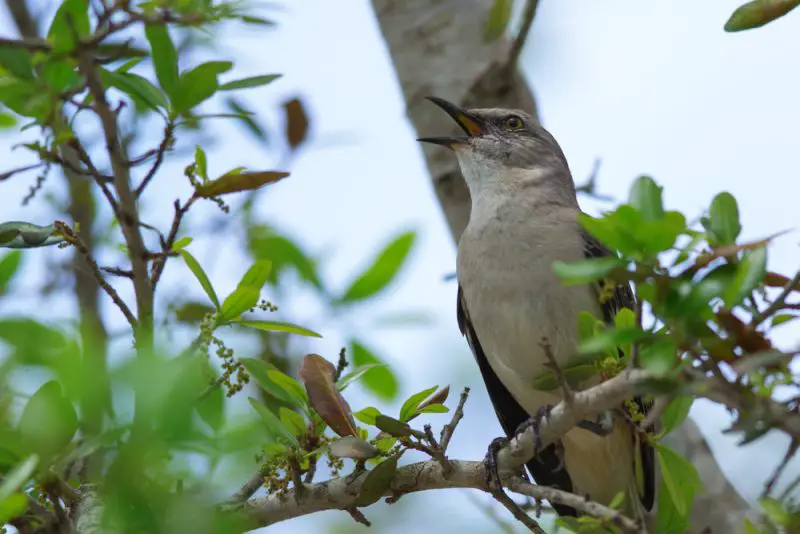
A medium-sized songbird with a long tail and a slenderer profile than a thrush. Mockingbirds are little birds with long legs and a long, thin beak with a downward bend. Their wings are small, rounded, and wide, giving the impression of a long tail when flying. Mockingbirds are known for their abilities to mimic noises from nature as well as urban and suburban environments. It has also been seen to imitate the songs of other birds, insects, frogs, and even automobile alarms. A single mockingbird has the ability to sing up to 200 distinct songs. In 1929, it was designated as Arkansas’ state bird.
Why Mockingbirds Is The State Bird of Arkansas?
Because of the exposure and lobbying efforts of the Arkansas Federation of Women’s Clubs (AFWC), which fought to safeguard several bird species in Arkansas, Arkansas acknowledged the mockingbird’s hard work. Ornithologist William Dutcher spoke at one of their 1903 meetings, alerting them to the mockingbird’s economic significance as a bug and weed seed eater. It gained popularity in the state because of its assistance to farmers and its beautiful music.
What Is The State Bird of California?
- Common Name: California quail
- Scientific Name: Callipepla californica
- Diet: Herbivores
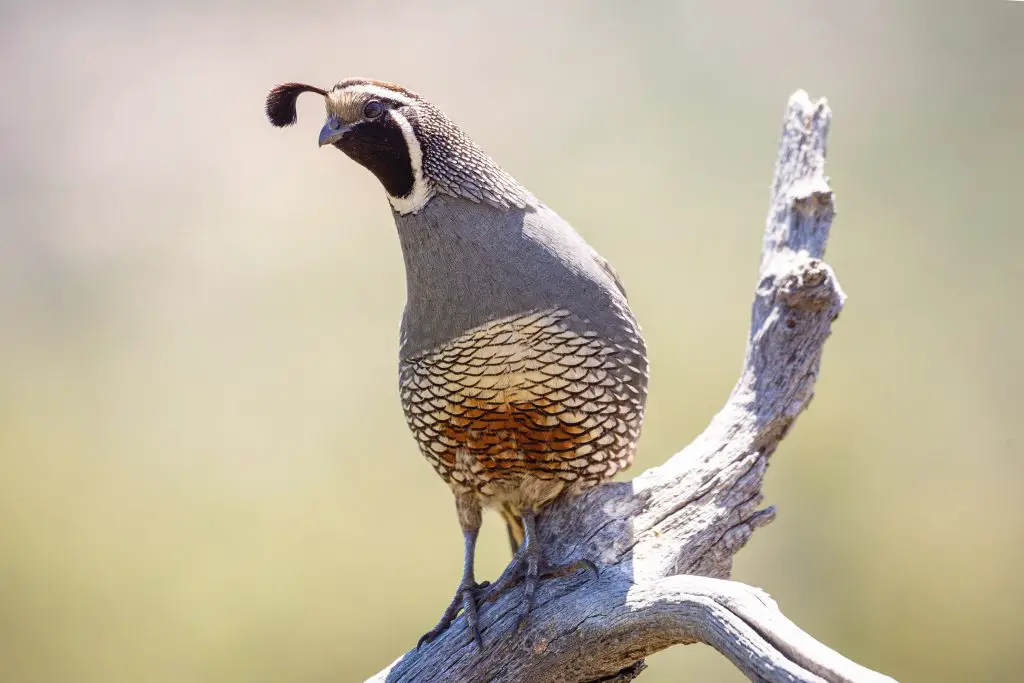
California Quail are plump game birds with short necks and tiny heads and beaks. They fly with short, wide wings. The tail is rather lengthy and square. Both sexes have a comma-shaped topknot of feathers protruding forward from the brow, with males having a longer topknot than females. The California quail is a small, chubby bird that is considered prey among hunters. Their grey and brown feathers, as well as their unusual patterns, are identifying features. They spend most of their time on the ground, nesting in leaf-covered hollows.
Why California Quail Is The State Bird of California?
The wild California quail was chosen as the official bird of California. This bird made its home in the state’s wide spaces, particularly along the shore. The Audubon Society was impressed by the valley quail’s resourcefulness, and it recommended it as the official state bird. The California Legislature agreed, enacting AB 776, designating the California valley quail as the state’s “official bird and avifaunal symbol.”
What Is The State Bird of Colorado?
- Common Name: Lark bunting
- Scientific Name: Calamospiza melanocorys
- Diet: Herbivores
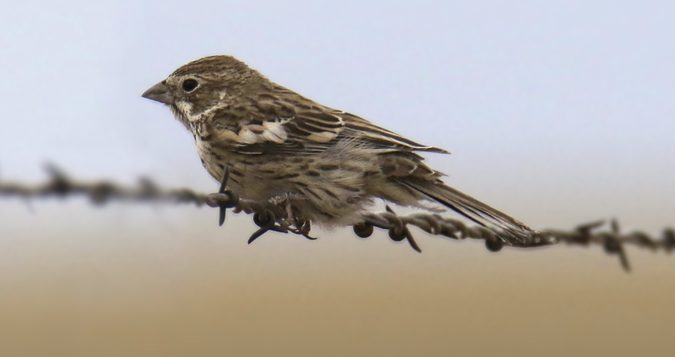
The lark bunting is a medium-sized American sparrow endemic to North America’s central and western regions. It is also Colorado’s state bird. Lark buntings are little songbirds with a blue beak that is short and thick. The wings feature a huge white patch, and the tail is quite short with white tips at the end of the feathers. Breeding males are completely black with a big white patch on the top half of the wing. However, the male’s wooing display is breathtaking. They sing a wonderful melody as they soar up from the green plains where they reside.
Why Lark Bunting Is The State Bird of Colorado?
In 1931, the lark bunting was named the official bird of Colorado. The lark bunting was chosen because of its unusual plumage and because its character was deemed to blend in with the spirit of Colorado. It’s actually a sparrow. The state’s citizens were won over by the native bird’s melodious song and acrobatic courting dance. The bedazzling dance done by the male bird seeking to capture the heart of a stunning female sparrow mesmerizes the residents.
What Is The State Bird of Connecticut?
- Common Name: American Robin
- Scientific Name: Turdus migratorius
- Diet: Omnivores
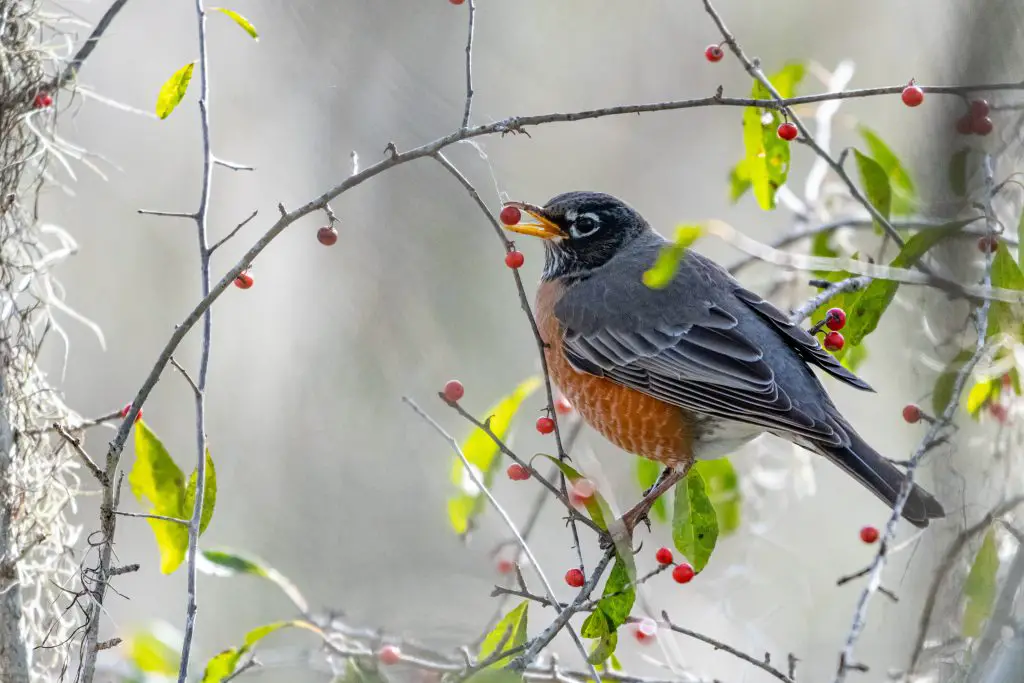
The American Robin popularly known as the robin redbreast was named the state bird of Connecticut in 1943. The gray-brown American Robin has warm orange underparts and a black head. A white patch on the lower abdomen and under the tail may be seen in flight. Females have lighter heads that contrast less with the grey back than males.
Why American Robin Is The State Bird of Connecticut?
While many American robins fly for the winter, Connecticut robins appear to enjoy the autumn beauty as much as tourists. Rather than being seasonal visitors, these birds live in the state all year. They nest high among pines in marshes during the hard-northern winters. All year long, these evergreen swamp inhabitants serenade the citizens of the state with a melody. The redbird’s devotion won it a particular place in the hearts of the people of the state.
What Is The State Bird of Delaware?
- Common Name: Blue Hen
- Scientific Name: Gallus gallus
- Diet Omnivores
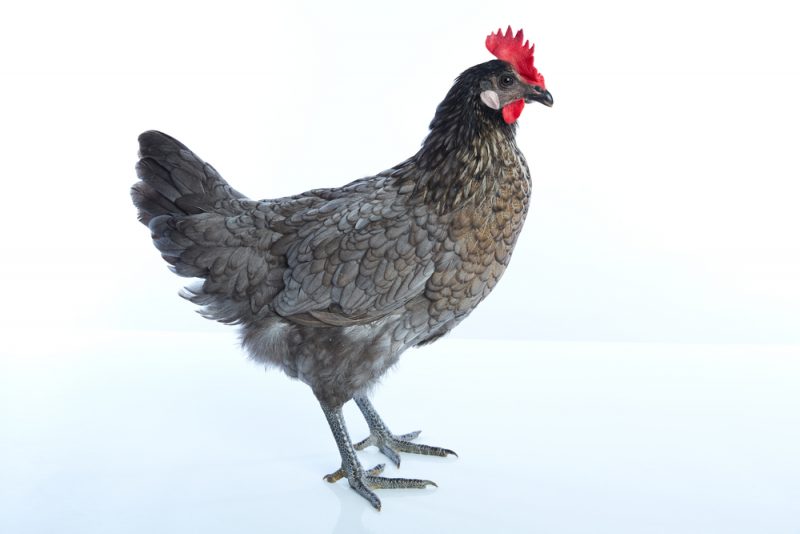
The Delaware Blue Hen is a blue American gamecock variety. It was designated as Delaware’s state bird on April 14, 1939. It is one of three U.S. state birds that are not native to the country. In 1911, the University of Delaware selected the bird as its mascot, demonstrating that the bird had already gained widespread popularity among Delaware people. The Blue Hen Chicken is another name for the Delaware Blue Hen.
Why Delaware Blue Hen Is The State Bird of Delaware?
Delaware was given its name from the fighting Blue Hen Cocks that were carried with Delaware Revolutionary War Soldiers for amusement during Cockfights. It all goes back to the Revolutionary War, when a company of Delaware troops reminded their captain so much of his farm hen’s fighting brood that he named them “The Blue Hen’s Chickens” and “Sons of the Blue Hen.”
What Is The State Bird of Florida?
- Common Name: Northern mockingbird
- Scientific Name: Mimus Polyglottos
- Diet: Omnivores

The Northern Mockingbird was chosen as the state bird of Florida. On April 23, 1927, Florida designated it as the state bird. Northern mockingbirds are medium-sized songbirds that have grey to brown bodies and a lighter underside. Their wings are circular, with white spots on the top and bottom surfaces that may be seen when the wings are spread. Male mockingbirds are somewhat bigger than female mockingbirds. This long-legged, medium-sized bird with a long tail is popular in the United States. This bird prefers to spend the winter in southern states, but it can also simply settle permanently in a state, as it did in Florida.
Why Northern Mockingbird Is The State Bird of Florida?
The small bird that sings for the public was chosen by Florida. The small bird provides a valuable service to the citizens of the state by eating insects that might otherwise bother them. As MSN pointed out, not every bug it consumes makes it to your patio. The official avian of Florida serves the state in a variety of capacities.
What Is The State Bird of Georgia?
- Common Name: Brown Thrasher
- Scientific Name: Toxostoma rufum
- Diet: Omnivores
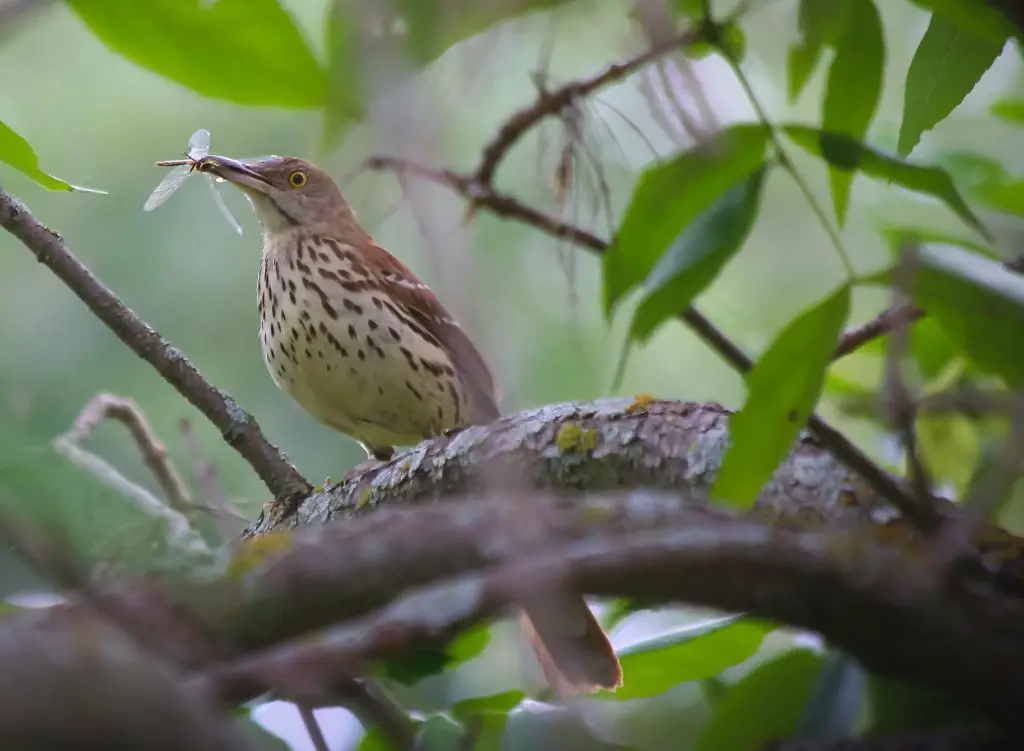
Brown Thrashers are bright brown birds with black striping on their pale underparts. The face is gray-brown, with two black-and-white wing bars. Their eyes are a vivid yellow. Brown Thrashers browse on the ground behind deep cover or lurk in shrubby tangles. The brown thrasher is known for its aggressive temperament and is a fierce defender of its nest. The term, however, is thought to have derived from the thrashing sound the bird produces when digging through ground detritus, rather than from fighting imagined dangers.
Why Brown Thrasher Is The State Bird of Georgia?
Although nothing is known about why the Brown Thrasher was chosen as Georgia’s state bird, it is thought that it was picked because of its distinctive song. The Brown Thrasher has a wide range of cries that resemble other birds, including one that sounds like a human kissing sound. The Cornell Lab estimates that the Brown Thrasher has around 1,100 sounds in its repertory. The brown thrasher, a huge, foxy red songbird with over 1,000 song varieties, was named Georgia’s state bird in 1935 by a governor’s proclamation. The legislature designated the thrasher as Georgia’s official state bird in 1970, at the request of the Garden Clubs of Georgia. The Brown Thrasher sings in phrases that are repeated twice before moving on to a different sound or phrase.
What Is The State Bird of Hawaii?
- Common Name: Hawaiian Goose
- Scientific Name: Branta sandvicensis
- Diet: Herbivores
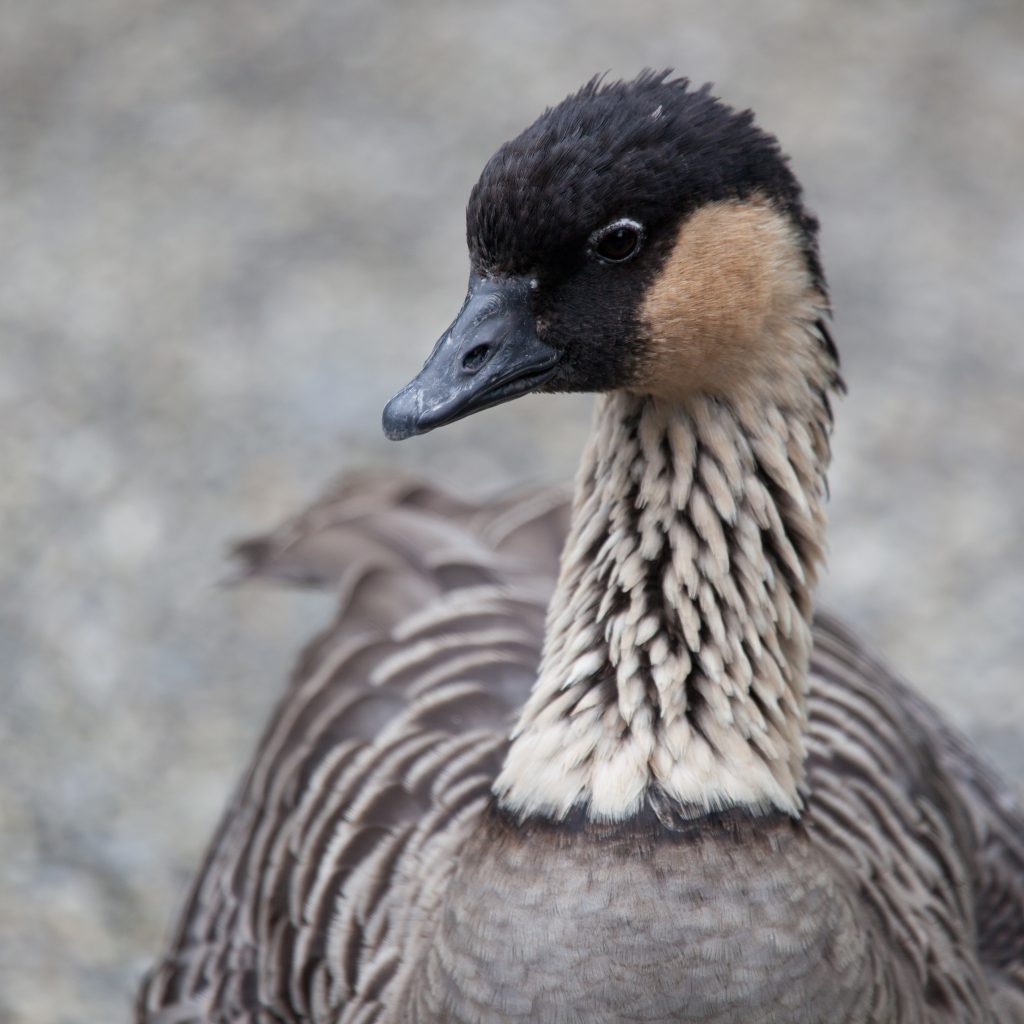
The Nene often known as the Hawaiian Goose was named the state bird of Hawaii in 1957. Hawaiian geese have black faces and crowns, as well as cream-colored cheeks. The neck is pale yellowish with black streaks and has a small dark ring at the base. Gray-brown body plumage and folded wings with transverse barring. The bill, legs, and feet are all black, but the iris is a dark brown color. The Nene (pronounced nay nay), a big, cream, tan, and black-colored bird unique to the Hawaiian island of Oahu, is unlike any other goose. This endangered bird is the only one of the island’s nine goose species that can still fly; the others have degenerated and become flightless.
Why Nene Goose Is The State Bird of Hawaii?
Hawaii designated the nene, often known as the Hawaiian goose, as its official bird. The nene used to occupy the islands, but just approximately 2,000 to 4,000 birds survive now. The nene was chosen as Hawaii’s official bird as part of a public education programme to educate its people about the significance of maintaining nature and native species. It also successfully advocated for the nene’s inclusion on the Federal List of Endangered Species in 1967.
The state of Hawaii has collaborated with the Wildfowl and Wetlands Trust (WWT) in England to raise nene outside of Hawaii and subsequently reintroduce the birds. This reduces inbreeding. Only 20 to 30 birds existed in 1949, but the late Sir Peter Scott brought two of them to England and nurtured them. More than 200 birds have been restored to the Hawaiian Islands because of the two relocated birds.
What Is The State Bird of Idaho?
- Common Name: Mountain Bluebird
- Scientific Name: Sialia currucoides
- Diet: Carnivores

The Mountain Bluebird often known as the bluebird was named the state bird of Idaho in 1931. Mountain bluebirds are six to seven inches long. It features a black beak that is tiny and pointed, as well as black legs and feet. The male is a rich sky blue on top and a lighter blue on the bottom, with a white tummy. The female’s wings are a duller blue-gray, and she has a grey neck, back, and crown. The male has blue and white feathers, while the female has brown and blue feathers. This thrush is recognized for its beautiful azure blue breast.
Why Mountain Bluebird Is The State Bird of Idaho?
Idaho declared the Mountain Bluebird its official bird in 1931. Idaho schoolchildren proposed that it be designated as the state bird. This bluebird takes its name from its habitat in Western North America’s mountains. This Mountain Bluebird will spend the most of the year in northern Idaho.
What Is The State Bird of Illinois?
- Common Name: Northern Cardinal
- Scientific Name: Cardinalis cardinalis
- Diet: Omnivores

The Northern Cardinal was chosen as the state bird of Illinois in 1929. The northern cardinal is a medium-sized songbird that is 21–23 cm (8.3–9.1 in) in length. It has a conspicuous crest on the head and a mask on the face that is black in males and grey in females. The male is a bright red, while the female is a reddish olive.
Why Northern Cardinal Is The State Bird of Illinois?
The medium-sized songbird picked Illinois as one of its home states because of its brilliant ruby red plumage. Northern Cardinals enjoy a balance of wooded and open settings; therefore, The Prairie State was an obvious choice for these birds.
In 1928, at the request of the Macomb section of the National Federation of Professional Women’s Clubs, Illinois schoolchildren voted on a state bird. The cardinal was not formally named the state bird until the following year by the legislature. Illinois was the first of seven states to choose this bird. The oriole, bluebird, meadowlark, and bobwhite were among the other contenders.
What Is The State Bird of Indiana?
- Common Name: Northern Cardinal
- Scientific Name: Cardinalis cardinalis
- Diet: Omnivores

The Northern Cardinal was named the state bird of Indiana in 1933. One of the native states of the medium-sized songbird recognized for its brilliant scarlet red plumage is Indiana. Northern Cardinals enjoy a balanced environment that includes both wooded and open regions.
Why Northern Cardinal Is The State Bird of Indiana?
States tend to select birds that are either native to their state or migrate there permanently. The cardinal, for example, spends the entire year in Indiana, nesting in briar thickets and low saplings. By consuming both garden insects and weed seeds, the bird gives inherent value to people. The bird’s amazing beauty and brilliant crimson color help it become the state bird.
What is the state bird of Iowa?
- Common Name: American Goldfinch
- Scientific Name: Spinus tristis
- Diet: Herbivores

The American Goldfinch often known as the eastern goldfinch, was chosen as the state bird of Iowa in 1933. American Goldfinches have bright yellow plumage with black on the crowns of their heads, wings, and tails. Their wings and tails also feature white barring and patterns. Females have slightly less vivid plumage than males. By choosing to stay in Iowa even during its cold, hard, snowy winters, the little yellow canary bird with a short, cone-shaped beak and a short, forked tail became the state’s favorite bird. Iowa, like the bird, showed fidelity.
Why American Goldfinch Is The State Bird of Iowa?
In 1933, the Eastern Goldfinch, commonly known as the American goldfinch and the wild canary, was named the official state bird by the General Assembly. It was chosen as the state bird since it is prevalent in Iowa and typically spends the winter there.
What Is The State Bird of Kansas?
- Common Name: Western Meadowlark
- Scientific Name: Sturnella neglecta
- Diet: Carnivores & Herbivores

The Western Meadowlark was named the state bird of Kansas in 1937. With its contemplative, reflective expression, the medium-sized, vividly colored, streaked, spotted meadowlark bird appears to examine everything that Kansas has to offer from its perch in the state’s vast grasslands. It eats largely bugs, although it will also eat seeds and berries.
Why Western Meadowlark Is The State Bird of Kansas?
The state bird of Kansas, the Sunflower State, is the wild meadowlark. This bird settled in the state’s sunflower fields and resounded with the youngsters of the state. The vivid yellow of its tummy and breast nicely resembles the sunflower petals. The Kansas Audubon Society chose the Western Meadowlark as the state bird after a poll of the state’s 121,000 schoolchildren. The meadowlark garnered 43,895 votes, while the Bobwhite and Cardinal were the closest competitors.
What Is The State Bird of Kentucky?
- Common Name: Northern Cardinal
- Scientific Name: Cardinalis cardinalis
- Diet: Omnivores

The Northern Cardinal (Cardinalis cardinalis) was chosen as the state bird of Kentucky twice, both times becoming state law. The brightly colored medium-sized songbird picked Kentucky as one of its native states in the United States. The Northern Cardinals will be delighted in the Bluegrass State, which has plenty of mesquite patches and streamside thickets.
Why Northern Cardinal Is The State Bird of Kentucky?
The Kentucky cardinal (Cardinalis cardinalis), sometimes known as the red bird, was formally designated as the state bird of Kentucky by a resolution passed by the Kentucky Senate on February 26, 1926, with the House of Representatives agreeing. The bird was chosen since it is indigenous to Kentucky.
What Is The State Bird of Louisiana?
- Common Name: Brown Pelican
- Scientific Name: Pelecanus occidentalis
- Diet: Omnivores

In 1966, Louisiana designated the Brown Pelican as its official bird. Although the bird breeds from South Carolina to Brazil, Louisiana is the only state that has chosen it as its state symbol. Brown Pelicans are gray-brown birds with yellow heads and white necks as adults. The back and sides of the neck turn a rich, dark reddish-brown in breeding plumage. Immatures are gray-brown on top (containing the head and neck), light white on the abdomen, and breast.
Why Brown Pelican Is The State Bird of Louisiana?
The pelican appears on Louisiana’s flag and state seal, and the state is known as “The Pelican State.” Since the arrival of early European settlers, who were captivated by the Pelican’s loving and maternal attitude toward their young, this bird has been a symbol of Louisiana. Because of the manner, it nurtures its young, the people of Louisiana called this bird their favorite bird. Both parents share parenting responsibilities, care for, and feed their children. While the young birds may leave the nest and mingle at five weeks, the family continues to eat together as they get older, with parents feeding the young long after they have left the bird colony. On the bayou, this idea of familial connection was appealing.
What Is The State Bird of Maine?
- Common Name: Black-capped chickadee
- Scientific Name: Poecile atricapillus
- Diet: Carnivores

The black-capped chickadee (Poecile atricapillus) was named the state bird of Maine in 1927. The black-capped chickadee has a wingspan of six to seven inches and measures four to five inches in length. It has grey upper sides and tail, a black cap and neck bib, white cheeks, a white chest and belly, and light brown flanks just under its wings. The chickadee is called for its distinctive “chick-a-dee-dee-dee” cry. This chickadee consumes largely insects but also plants, including poison ivy.
Why Black-Capped Chickadee Is The State Bird of Maine?
As it turns out, Maine’s legislators were not very concerned with precision when they picked the bird to represent us. They picked “the chickadee” as Maine’s State Bird, despite the fact that the state is home to two kinds of chickadees: the Black-capped and the Boreal. Cottonwood groves, deciduous and mixed forests, open woodlands, willow thickets, and even parks are all favorites of these birds. The black-capped chickadee is a fantastic addition to the citizens of the state since it embraces everything with enthusiasm.
What Is The State Bird of Maryland?
- Common Name: Baltimore oriole
- Scientific Name: Icterus galbula
- Diet: Omnivores

The Baltimore oriole was named (Icterus galbula) the state bird of Maryland in 1947. Adult male Baltimore orioles have eye-catching colors, with dazzling orange plumage on their undersides and shoulders. The male bird has a black head and beak, as well as black wings with a white band running across them. Maryland added the bird to the Nongame and Endangered Species Conservation Act in 1975, further protecting it. The bird’s survival has been threatened since the 1980s, despite these two legislative initiatives.
Why Baltimore Oriole The State Bird of Maryland?
“Baltimore Birds” were among the “Beasts of Curiosity” transported from Maryland to beautify the royal gardens in 1698. (Archives of Maryland 23: 455-56). Baltimore’s major league baseball club (The Baltimore Orioles) was named after the bird in 1894.”
What Is The State Bird of Massachusetts?
- Common Name: Black-capped chickadee
- Scientific Name: Poecile atricapillus
- Diet: Carnivores

The black-capped chickadee (Poecile atricapillus) was named the state bird of Massachusetts in 1941. The little black and white bird with an enormous head enthusiastically welcomes the Massachusetts people. Chickadees, sometimes called black-cap titmice’s, prefer deciduous and mixed woodlands. This chickadee consumes largely insects but also plants, including poison ivy.
Why Black-Capped Chickadee Is The State Bird of Massachusetts?
Massachusetts picked the wild black-capped chickadee as its state bird but did not explain why in its statute. This bird established in all of the state’s wooded habitats, including cottonwood groves, deciduous and mixed forests, open woodlands, willow thickets, and even parks. The best argument is that its attractiveness took on and appealed to the citizens of the state. The departing bird approaches humans boldly. The black-capped chickadee pursues life with enthusiasm, making it a welcome addition to the state’s population.
What Is The State Bird of Michigan?
- Common Name: American Robin
- Scientific Name: Turdus migratorius
- Diet: Omnivores

The American Robin (Turdus migratorius), popularly known as the robin redbreast, was named the state bird of Michigan in 1931. The chest feathers of this migratory songbird, which are famed for their red breast, range in color from peach to deep maroon.
Why American Robin Is The State Bird of Michigan?
The American robin won a competition to be named Michigan’s state bird. “The robin is the best recognized and most loved of all the birds in the State of Michigan,” House Concurrent Resolution 30 stated, according to several sources. Most Michigan backyards, forests, and parks are home to the bird.
Legislators selected the robin as the state bird in 1931, with the support of the prominent Michigan Audubon Society, and it became official on April 8, that year. The red-breasted bug-gobblers were dubbed “the best known and most liked of all the birds in the state of Michigan” at the time.
What Is The State Bird of Minnesota?
- Common Name: Common loon
- Scientific Name: Gavia immer
- Diet: Carnivores

The Common loon (Gavia immer) was named the state bird of Minnesota in 1961. The common loon is a huge diving water bird with rounded heads and a dagger-like beak. They have lengthy bodies with small tails that are normally hidden. They seem stretched out in flight, with a long, flat body and a long neck and beak. With wingspans of up to five feet, the huge black and white loon is an impressive avian specimen. The Great Northern Diver is another name for the Common Loon.
Why Common Loon Is The State Bird of Minnesota?
While Minnesota has over 15,000 lakes with a surface area of at least 10 acres, Governor Elmer Andersen signed Chapter 76 into law in 1961, designating the Common Loon as the state bird.
The Minnesotans were presumably amazed by these powerful, nimble divers’ fishing ability. They swiftly capture little fish from the lake’s waters. You may fool a less informed individual into thinking the lake is haunted by their haunting sounds that reverberate across the state’s waterways. However, it is exclusively home to Minnesota’s state bird. The only state with a bigger number of these birds is Alaska.
What is the state bird of Mississippi?
- Common Name: Northern mockingbird
- Scientific Name: Mimus Polyglottos
- Diet: Omnivores

The Northern mockingbird (Mimus Polyglottos) was chosen as Mississippi’s state bird. On February 23, 1944, Mississippi designated it as the state bird. This long-legged, medium-sized bird with a long tail does not require any encouragement to sing. This bird prefers to spend the winter in southern states, although some that dwell in Mississippi do so all year.
Why Northern Mockingbird Is The State Bird of Mississippi?
The Mockingbird is Mississippi’s official state bird. The Women’s Federated Clubs picked it, and the Mississippi State Legislature formally accepted it on February 23, 1944. The Northern Mockingbird is the only mockingbird found in North America.
What Is The State Bird of Missouri?
- Common Name: Eastern Bluebird
- Scientific Name: Sialia sialis
- Diet: Carnivores

The Eastern Bluebird (Sialia sialis) was named the state bird of Missouri in 1927. Male Eastern Bluebirds have a bright, deep blue upper body with a rusty or brick red neck and breast. Males typically appear plain gray-brown from a distance, while blue in birds is always dependent on the light. Females have grey wings and tails, as well as a muted orange-brown breast. The bird, whose population had plummeted in the 1950s, now breeds in nesting boxes across the state. The melodic abilities of this small songbird are well-known.
Why Eastern Bluebird Is The State Bird of Missouri?
The Eastern Bluebird was chosen as Missouri’s state bird because it is “common in Missouri” and gives “a symbol of happiness” with its happy singing. The bluebird, according to naturalist Henry David Thoreau, “carries the sky on its back.” The bluebird is so beloved in the state that birdhouses have been erected for it at regular intervals. In the spring, you’ll see the bird fluttering from one fencepost to the next and hear its “cheer-cheery up” song as you drive through the countryside of Missouri.
What Is the State Bird of Montana?
- Common Name: Western Meadowlark
- Scientific Name: Sturnella neglecta
- Diet: Carnivores & Herbivores

The Western Meadowlark was chosen the official bird of Montana in 193. Western Meadowlarks have yellow underparts and brown, black, and buff upperparts with elaborate patterns. The brilliant yellow breast is crossed with a black “V,” which is grey in the winter. The head is marked by dark brown and light buff stripes. The brilliant hues of this meadowlark make it easy to identify. From its perch in Montana’s vast grasslands, this medium-sized bird, striped and speckled, appears to examine everything the state has to offer. With its contemplative, introspective gaze, the Western meadowlark topped the list of the state’s pupils. This carnivore may be seen eating bugs, but it will also eat seeds and berries if necessary.
Why Western Meadowlark Is The State Bird of Montana?
The Western Meadowlark is Montana’s state bird (Sturnella neglecta). The western meadowlark was chosen by Montana youngsters as the greatest representative of the state and was formally recognized by the Montana Assembly on March 14, 1931. The bright, cheery chirping of the western meadowlark is well known.
What Is The State Bird of Nebraska?
- Common Name: Western meadowlark
- Scientific Name: Sturnella neglecta
- Diet: Carnivores & Herbivores

You might notice a streak of yellow and tan flitting by you as you drive across Nebraska. Since 1929, the Western meadowlark (Sturnella neglecta) has been the state bird. This bright medium-sized bird is a blackbird, not a lark. Because the male of the species is protective of his spouse and kids, the bird is known for its contemplative stare. It prefers to sit to the buttes and plains.
Why Western Meadowlark Is The State Bird of Nebraska?
In 1929, the Western Meadowlark was named Nebraska’s State Bird due to its widespread distribution and happy singing. In 1947, the Western Meadowlark was named the state bird of North Dakota.
What Is The State Bird of Nevada?
- Common Name: Mountain bluebird
- Scientific Name: Sialia currucoides
- Diet: Carnivores

The mountain bluebird (Sialia currucoides), usually known as the bluebird, was chosen by the state of Nevada in 1967. The mountain bluebird is a little migratory thrush found in western North America’s hilly regions. It has dark eyes and a light underbelly. Males have narrow bills and are vivid turquoise-blue with a paler underbelly.
Why Mountain Bluebird Is The State Bird of Nevada?
The mountain bluebird is the state bird of Nevada. The legislature formally approved it on April 4, 1967. Mountain Bluebirds (Sialia currucoides) reside in Nevada’s high terrain and eat a variety of insects.
The mountain bluebird spends the entire year in Nevada. It is a resident of the Nevada high country, singing its warbled song throughout the year. The bluebird’s devotion won it a particular place in the hearts of the people of the state. The state and federal governments categorized this bird as endangered because pesticide usage and the decline of ancient trees have led it to lose breeding grounds.
What Is The State Bird of New Hampshire?
- Common Name: Purple Finch
- Scientific Name: Haemorhous purpureus
- Diet: Herbivores

The Purple Finch (Haemorhous purpureus) was named the state bird of New Hampshire in 1957. Purple Finches males have a delicate pink-red head and breast, with brown on the back and foggy white on the belly. Purple Finches have no red on their females. They have a pale eyestripe and a black line along the side of their throat, and are coarsely streaked on the bottom. Purple finches may be seen throughout the state all year save during the winter. It migrates south, like many other migratory birds, to avoid the severe winter temperatures and snow of northern states like New Hampshire.
Why Purple Finch Is The State Bird of New Hampshire?
On April 25, 1957, the state assembly of New Hampshire designated the purple finch as the state bird. The bird triumphed in a legislative battle against the New Hampshire hen, which had the support of a state politician. The finch had more support, and the politician who supported the hen’s bill was pigeonholed.
What is the state bird of New Jersey?
- Common Name: American Goldfinch
- Scientific Name: Carduelis tristis
- Diet: Herbivores

The American Goldfinch (Carduelis tristis), often known as the eastern goldfinch, was named the state bird of New Jersey in 1935. By eating the weed’s seeds, the little yellow canary bird with a short, cone-shaped beak and a short, forked tail helps reduce ragweed development in New Jersey.
Why American Goldfinch Is The State Bird of New Jersey?
Because the wild canary, also known as the American Goldfinch, prefers broad open spaces and meadows, the Garden State of New Jersey seemed an obvious option. The bird sings to New Jersey people on a daily basis, and the state honors its devotion by designating it as the state bird.
What Is The State Bird of New Mexico
- Common Name: Greater roadrunner
- Scientific Name: Geococcyx californianus
- Diet: Carnivores

The greater roadrunner is the state bird of New Mexico. The cuckoo family includes the larger roadrunner. It’s a little ground bird with a wingspan of roughly two feet. On its back and wings are speckled brown and black feathers, with a paler neck and breast with dark lines. It has a long tail, long legs, and golden eyes.
Why Greater Roadrunner Is The State Bird of New Mexico?
The Native Americans of New Mexico admire the speed of this bird, which can run up to 20 miles per hour on foot. The bird spends the most of its time in desert conditions, preferring New Mexico, Arizona, California, Oklahoma, and Texas.
What Is The State Bird of New York?
- Common Name: Eastern bluebird
- Scientific Name: Sialia sialis
- Diet: Carnivores

A bluebird can identify caterpillars and insects in thick grass from more than 50 yards away. Female bluebirds of all species have duller plumage than males, which might make them less visible to predators. Bluebirds’ feathers are devoid of blue pigments.
Why Eastern Bluebird Is The State Bird of New York?
When the state of New York named the Eastern Bluebird (Sialia sialis) as its official bird in 1970, it became the final state to do so. The bird, whose population had plummeted in the 1950s, now nests in nesting boxes across the state. The melodic qualities of this small songbird is well-known.
What Is The State Bird of North Carolina?
- Common Name: Cardinal
- Scientific Name: Cardinalidae
- Diet: Omnivores

It has a small, cone-shaped beak, a black mask on its face, and a crest on its head. The female mask is generally lighter in colour than the male mask. The male cardinal is the only one who is vivid red. The female is a dark brown or olive tint with a dull red tail and wings. North Carolina did not identify a state bird until 1943, after waiting a long time to do so.
Why Cardinal Is The State Bird of North Carolina?
The state of North Carolina acknowledges the usefulness of the bird to people since it consumes weed seeds and garden insects, according to North Carolina General Statutes Chapter 145, Section 145-2. The state dubbed it the state bird for its valuable services in keeping fields and gardens free of dangerous plants and animals.
What Is The State Bird of North Dakota?
- Common Name: Western Meadowlark
- Scientific Name: Sturnella neglecta
- Diet: Carnivores & Herbivores

Western Meadowlarks have pale brown upperparts with a prominent black V across the chest and brilliant yellow underparts. The outside feathers of the tail are white and visible during flight, despite the fact that the majority of the tail is brown with blackish barring. Western Meadowlarks are ground-dwelling birds that are typically hidden by grasses or crops. North Dakota went without a state bird until 1947, when the Western Meadowlark was chosen.
Why Western Meadowlark Is The State Bird of North Dakota?
The western meadowlark (Sturnella neglecta) is North Dakota’s official state bird. In 1947, the state legislature formally adopted it. It was chosen as North Dakota’s state bird because it can be found in abundance throughout the state, and probably because of its charming songs.
What is the state bird of Ohio?
- Common Name: Cardinal
- Scientific Name: Cardinalis cardinalis
- Diet: Omnivores

Cardinals are known for fiercely defending their territories, making them an appropriate mascot for sports teams. The NFL’s Arizona Cardinals and Major League Baseball’s St. Louis Cardinals are both named for this bright red bird and its battling attitude. Cardinals are bright red all throughout, with a reddish bill and a black face surrounding the bill. The wings, tail, and crest of females are all warm crimson tinges. Their black faces and red-orange bills are identical.
Why Cardinal Is The State Bird of Ohio?
The Cardinal (Cardinalis cardinalis) was named the official state bird of Ohio in 1933 due to its widespread distribution. However, this was not always the case. Cardinals prefer to live in thickets and shrubs on the boundaries of woodlands and fields.
What Is The State Bird of Oklahoma?
- Common Name: Scissor-tailed flycatchers
- Scientific Name: Tyrannus forficatus
- Diet: Omnivores
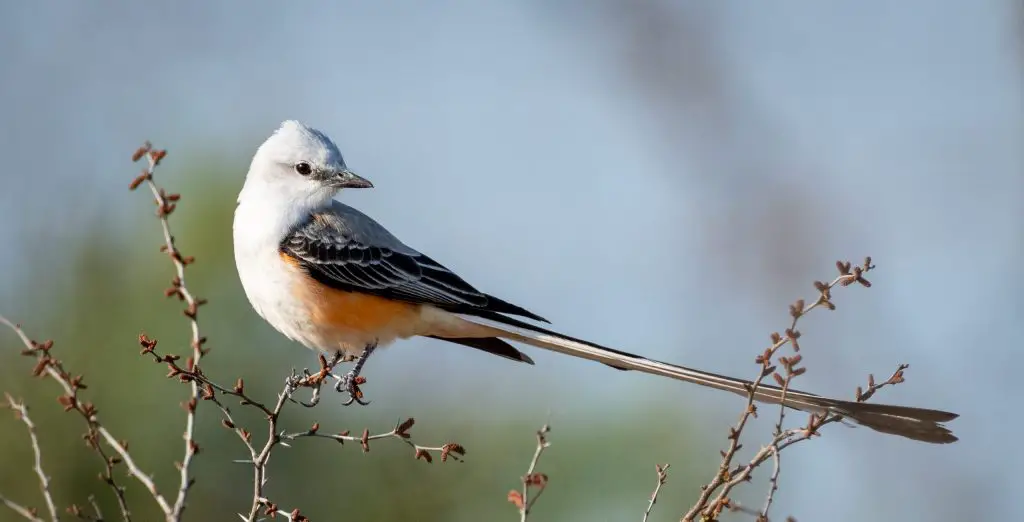
Scissor-tailed flycatchers have thin bodies, pale grey and black tails, and pink sides, with red spots immediately behind the wings at the shoulders. Long rectrices with a gap between them give the appearance of scissors, hence the common name. The Scissor-tailed Flycatcher (formerly Muscivora forficate; now Tyrannus forficatus) was named the state bird of Oklahoma in 1951.
Why Scissor-Tailed Flycatcher Is The State Bird of Oklahoma?
Despite an unsuccessful first attempt to make the bird the official symbol, the scissortail was eventually chosen because of its diet of dangerous insects, its nesting range in Oklahoma, and the fortunate fact that no other state had named it.
What Is The State Bird of Oregon?
- Common Name: Western Meadowlark
- Scientific Name: Sturnella neglecta
- Diet: Carnivores & Herbivores

Western Meadowlarks have pale brown upperparts with a prominent black V across the chest and brilliant yellow underparts. The outside feathers of the tail are white and visible during flight, despite the fact that the majority of the tail is brown with blackish barring. Eastern Meadowlarks are ground-dwelling birds that are typically hidden by grasses or crops. The Western meadowlark (Sturnella neglecta) was named the state bird of Oregon in 1927.
Why Western Meadowlark Is The State Bird of Oregon?
It has a bright yellow breast and belly with a striking black V across the chest and a habit of perching on fences along roadsides, making it one of Oregon’s most distinctive birds. It was named Oregon’s state bird in 1927 after a vote of Oregon students was validated by the legislature.
What is the state bird of Pennsylvania?
- Common Name: Ruffed Grouse
- Scientific Name: Bonasa umbellus
- Diet: Omnivores

The ruffed grouse is a chicken-sized bird with a length of 16-19 inches. It has a small crest on its head and reddish-brown to gray-brown plumage. It has a black ruff around its neck and banded flanks. It has a long, square, flat tail and a small, pointed bill. The ruffed grouse (Bonasa umbellus) was named the state bird of Pennsylvania in 1931.
Why Ruffed Grouse Is The State Bird of Pennsylvania?
Pennsylvania has yet to adopt an official state bird, according to the E-Reference Desk. Instead, the ruffed grouse was designated as the state game bird in 1931. The bird, which lives in the state’s woodlands, offered an important source of food for the state’s settlers.
What Is The State Bird of Rhode Island?
- Common Name: Rhode Island Red
- Scientific Name: Gallus gallus
- Diet: Carnivores

Red-orange eyes, reddish-brown beaks, and yellow feet and legs, with a reddish color on the toes and sides of the shanks, distinguish Rhode Island Reds. The hue of the chicks ranges from bright red to tan. The roosters normally weigh around 8.5 pounds while the hens weigh around 6.5 pounds. The Rhode Island Red chicken (gallus domesticus) was named the official bird of Rhode Island in 1954.
Why Rhode Island Red Is The State Bird of Rhode Island?
In the late 1800s, breeders created the Rhode Island Red chicken as a utility bird. The chicken that has been designated as the state bird provides both meat and eggs. They are suitable as free-range or backyard chickens. They’re noted for being excellent egg layers, laying 200 to 300 eggs every year.
What Is The State Bird of South Carolina?
- Common Name: Carolina Wren
- Scientific Name: Thryothorus ludovicianus
- Diet: Carnivores

The Carolina Wren is a small, chunky bird with a spherical body and a long tail that cocks upward frequently. The head is big, with a short neck, and the bill is long, slender, and down curved, identifying it as a wren. The great Carolina Wren (Thryothorus ludovicianus) was named the state bird of South Carolina in 1948.
Why Carolina Wren Is The State Bird of South Carolina?
The Carolina wren is a little, active bird with a wingspan of five to six inches that can be found in both human and natural environments. Bird of state On April 3, 1948, Governor Strom Thurmond signed an act making the Carolina wren (Thyrothorus ludovicianus) the official state bird of South Carolina.
What is the state bird of South Dakota?
- Common Name: Ring-Necked Pheasant
- Scientific Name: Phasianus colchicus
- Diet: Omnivores

The body of common pheasants is deep, and pear-shaped, with small heads and long, thin tails. Males are more colorful and larger than females, and they are sexually dimorphic. Males have multicolored plumage with long, banded tails and fleshy crimson eye patches. The Ring-necked Pheasant (Phasianus colchicus) was named the state bird of South Dakota in 1943.
Why Ring-Necked Pheasant Is The State Bird of South Dakota?
The Ring-necked Pheasant (Phasianus colchicus) was named the state bird of South Dakota in 1943. The bird, officially known as the Chinese ring-necked pheasant, did not originate in the United States. South Dakotans fell in love with it after it was introduced to the state in 1898 for its plumage and delectable flesh.
What is the state bird of Tennessee?
- Common Name: Northern Mockingbird
- Scientific Name: Mimus polyglottos
- Diet: Omnivores

A medium-sized songbird with a longer tail and a slightly more slender appearance than a thrush. Mockingbirds have small heads and long legs, as well as a long, thin beak with a downward slope. Their wings are short, rounded, and broad, giving the impression that the tail is unusually lengthy when flying. The Northern Mockingbird (Mimus Polyglottos) was chosen as Tennessee’s state bird. On April 19, 1933, Tennessee designated it as the state bird.
Why Northern Mockingbird Is The State Bird of Tennessee?
When the pet trade faded, the birds began to repopulate the continent. They can now be found all the way up in Maine! The northern mockingbird was named Tennessee’s state bird in 1933 because the state recognized it as a real inhabitant.
What Is The State Bird of Texas?
- Common Name: Northern Mockingbird
- Scientific Name: Mimus polyglottos
- Diet: Omnivores

Northern mockingbirds are medium-sized songbirds with a lighter underside and grey to brown body color. Their wings are circular, with white patches on the upper and bottom surfaces that are evident when they are spread out. Male mockingbirds are larger than female mockingbirds. The Northern mockingbird (Mimus Polyglottos) was named the state bird of Texas in 1927.
Why Northern Mockingbird Is The State Bird of Texas?
Texas acknowledged its state bird’s commitment because it remained constant over the state’s scorching summers and bitterly frigid winters. The Northern mockingbird did not migrate south during the winter and continues to do so today. It spends the entire year in Texas. The bill proclaiming it the state bird, Senate Concurrent Resolution No. 8, 40th Legislature, says that the bird “remains protective of its territory like any real Texan.”
What Is The State Bird of Utah?
- Common Name: California Gulls
- Scientific Name: Larus californicus
- Diet: Carnivores

California gulls are medium-sized seabirds native to North America. Adults have a rounded head, yellow legs, brown eyes, and a short yellow beak with a black ring. The majority of their body is white, with a grey back and top wings. Their primaries are black with white tips. The California seagull (Larus californicus) was chosen as the official bird of Utah in 1955.
Why California Gull Is The State Bird of Utah?
The California gull is the state bird of Utah by popular vote, most likely in honor of the fact that in 1848, these gulls saved the people of Utah by devouring swarms of crickets that were ruining the crops.
What Is The State Bird of Vermont?
- Common Name: Hermit Thrush
- Scientific Name: Catharus guttatus
- Diet: Omnivores

The Hermit Thrush has a deep brown head and back, as well as a warm reddish tail. The underbelly is pale, with smudged markings on the breast and definite marks on the throat. A faint pale eyering can be seen if you look closely (not a bold one). Foraging Hermit Thrushes hop and scrape through leaf litter. The Hermit Thrush (Catharus guttatus) was named the state bird of Vermont in 1941.
Why Hermit Thrush Is The State Bird of Vermont?
Because some legislators preferred the crow or blue jay, nature groups supporting the hermit thrush fought in front of them. Hermit Thrushes can be found throughout the year in Vermont. While some legislators claimed the bird was not a “genuine Vermonter,” others persisted, and the hermit thrush won the day thanks to its “distinctive lovely call” and presence in all 14 counties.
What Is The State Bird of Virginia?
- Common Name: Northern Cardinal
- Scientific Name: Cardinalis cardinalis
- Diet: Omnivores

The northern cardinal is a medium-sized songbird that is 21–23 cm (8.3–9.1 in) in length. It has a characteristic crest on the head and a black or grey mask on the face in the male and female. The male is a bright red color, while the female is a reddish olive.
Why Northern Cardinal Is The State Bird of Virginia?
The Cavalier State waited over two centuries to designate its state bird, despite declaring independence in 1776 as one of the original colonies. The Northern Cardinal was chosen as the state bird by the Virginia General Assembly in 1950.
What is the state bird of Washington?
- Common Name: American Goldfinch
- Scientific Name: Spinus tristis
- Diet: Carnivores

Goldfinch, any of numerous species of the songbird family Fringillidae belonging to the genus Ciardellis (some originally in Spines); they have short, notched tails and bright yellow plumage. For finches, all have delicate sharp-pointed bills. Goldfinches eat on weeds in fields and gardens in large flocks. In the state of Washington, the state bird has been a source of contention. In 1951, the state formally chose the American Goldfinch (Spinus tristis) after more than two decades of vote and debate.
Why American Goldfinch Is The State Bird of Washington?
Because two other states had already chosen the American Goldfinch as their state bird, the State Legislature opted to let schoolchildren make the final decision. Children voted for the goldfinch in 1951, and the Legislature unanimously declared the “Willow Goldfinch” the official Washington State Bird.
What Is The State Bird of West Virginia?
- Common Name: Northern cardinal
- Scientific Name: Cardinalis cardinalis
- Diet: Omnivores

It has a small, cone-shaped beak, a black mask on its face, and a crest on its head. The female mask is usually lighter in color than the male mask. The male cardinal is the only one who is vivid red. The female is a dull brown or olive tint with a dull red tail and wings.
Why Northern Cardinal Is The State Bird of West Virginia?
The state bird was chosen by schoolchildren, sporting groups, and birding clubs in 1949. The Northern cardinal, sometimes known as the redbird, was overwhelmingly chosen. The friendly bird, a native of West Virginia, reminded settlers from Europe of the vestments worn by cardinals of the Catholic Church. The link stayed, and when scientists named the bird, the Catholic connotation was incorporated into the scientific nomenclature.
What Is The State Bird of Wisconsin?
- Common Name: American Robin
- Scientific Name: Turdus migratorius
- Diet: Omnivores

The American Robin has a brick-red breast, grey wings, head, and back, and is about 10 inches long (25 cm). The slender yellow beak has a grey tip. The male has a darker neck than the female, which is white with black lines. White dominates the lower belly. The robin redbreast became Wisconsin’s state bird in 1949.
Why American Robin is the state bird of Wisconsin?
In 1949, Wisconsin made the American robin its official state bird. The robin garnered twice as many votes as any other bird in a poll conducted by Wisconsin schoolchildren in 1926-27. In 1971, Wisconsin adopted another bird as its official symbol of peace: the mourning dove.
Why are Birds Often Chosen as State Animals in America?
Birds are often chosen as state animals in America because of their significant symbolism. They represent freedom, strength, and beauty, qualities that resonate with many American states. Birds also have a rich cultural significance throughout American history. For example, the bald eagle is the national bird and symbolizes freedom, while the wild turkey is the state bird of several states, reflecting their historical and cultural importance. State animals in america with explanations are carefully chosen to reflect the values and identity of each state.
What Is The State Bird of Wyoming?
- Common Name: Western Meadowlark
- Scientific Name: Sturnella neglecta
- Diet: Carnivores & Herbivores

Western Meadowlark has pale brown upperparts with a prominent black V across the chest and brilliant yellow underparts. The outside feathers of the tail are white and visible during flight, despite the fact that the majority of the tail is brown with blackish barring. Western Meadowlark is a ground-dwelling bird that is typically hidden by grasses or crops. Wyoming designated the sunshine-colored Western meadowlark (Sturnella neglecta) as its state bird in 1927.
Why Western Meadowlark Is The State Bird of Wyoming?
The meadowlark was a popular candidate for Wyoming’s state bird because it helps control dangerous insects, has a lovely singing, and can be found in meadows and open fields throughout the state.

